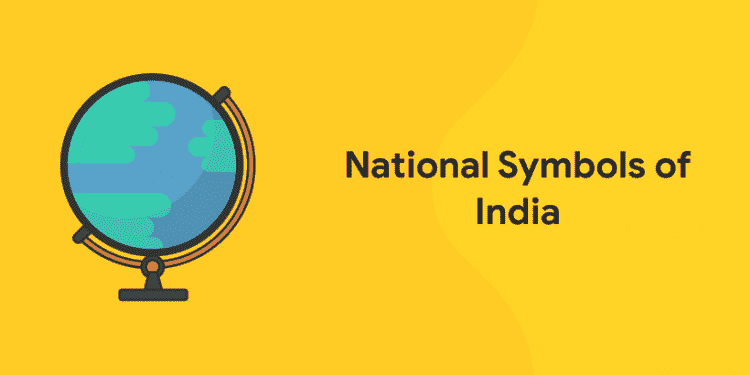The national symbol of India represents the distinctive and individuality of the country. These symbols are designed to be inclusive and representative of all the people of the national community. The National symbols of India have been chosen very carefully as they represent the culture, values, goals, national people and also the nature of India.
Here is the list of 15 National symbols of India you should know.
Download Entri App for competitive exam preparation!
National Symbols of India
| SR NO. | TITLE | SYMBOL | DESCRIPTION |
| 1. | National Flag | Tiranga (Tricolour Flag) | The Triranga is horizontal rectangular in shape. It has three colors- Saffron, White, Green and a Blue color wheel with 24 spokes known as Ashoka Chakra in it. The Flag was designed by Pingali Venkayya. |
| 2. | National Emblem | National Emblem of India | The Lion Capital of Ashoka at Sarnath is the national emblem of India. It was adopted on 26th January 1950, the day India got Republic. It consists of four Asiatic Lions standing back to back on a circular abacus. The abacus has sculptures of an elephant, a horse, a bull and a lion. These are separated by wheels in between. The national emblem stands on a full-bloomed inverted lotus flower. |
| 3. | National Anthem | Jana Gana Mana | The national anthem was originally composed in Bengali by Rabindranath Tagore. It was adopted as the National Anthem of India on January 24, 1950. |
| 4. | National Song | Vande Mataram | The National Song of India was composed in Sanskrit by Bankimchandra Chatterjee. It was adopted and a National Song on 24th January 1950. |
| 5. | National Animal | Royal Bengal Tiger | The basic aspect of Tiger is strength, agility, and power. The Royal Bengal Tiger was declared as the National Animal of India in April 1973. |
| 6. | National Bird | Indian Peacock | An Indian peacock represents the unity of vivid colors, symbolizes grace, beauty and finds references in Indian culture. On 1st February 1963 Indian Peacock was declared as a National Bird. |
| 7. | National Flower | Lotus | The Lotus Flower holds a very important position in Indian mythology. It is a flower of Goddess Laxmi and symbolizes wealth, prosperity and fertility. It also symbolizes purity, achievement, long life and good fate. |
| 8. | National River | The Ganga | The Ganga river flows over 2510 km of mountains, plains, and valleys. It is the longest river in the country. |
| 9. | National Tree | Indian Banyan | Indian Banyan tree symbolizes eternal life and longevity. It is also known as Kalpavriksha. |
| 10. | National Fruit | Mango | Mango has more than 100 varieties of the fruit. Mangos are cultivated in India from ancient times. |
| 11. | National Aquatic Animal | Ganges River Dolphin | Ganges River Dolphin is also known as River Dolphin. River Dolphin is basically blind and survives only in freshwaters. |
| 12. | National Heritage Animal | Indian Elephant | Indian Elephant was adopted as a national heritage Animal on October 22, 2010. The Indian elephant is a subspecies of the Asian elephant and found in mainland Asia |
| 13. | National Game | Hockey | Hockey has won eight gold medals in Olympic. Indian Hockey’s golden period was from 1928-56, where India won consecutive six medals in Olympic and hence it is considered as the National Game of India. |
| 14. | National Calendar | Saka Calendar | Saka Calendar was introduced by the calendar committee in 1957 and came into usage from March 22, 1957. |
| 15. | National Currency | Indian Rupee | The Indian Rupee was adopted by the Indian government on 15th July 2010. |
Each National symbol depicts the country’s image. The national animal, tiger symbolizes power; the national flower, lotus symbolizes purity; the national tree, banyan symbolizes immortality, the national bird, the peacock symbolizes elegance and the national fruit, mango symbolizes the tropical climate of India.
Similarly, our national song and national anthem were a source of inspiration during the freedom struggle. The national emblem of India depicts four lions standing back to back, symbolizing power, courage, pride, and confidence. The game of hockey was at its peak when it was adopted as the national game of India.











